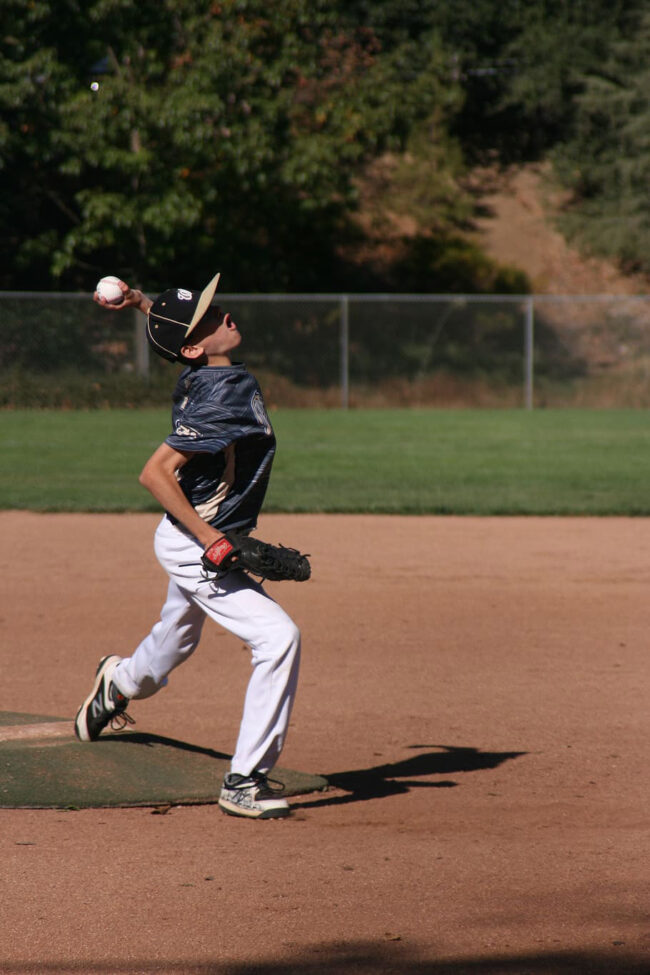
By Dr. John R. Mishock
Growth-plate injuries of the shoulder and elbow are common injuries in youth and adolescent baseball players. The growth-plate (epiphyseal plate or physis) is an area of cartilage at the end of a bone that is responsible for the bones growth. The growth plates close at the completion of bone growth during maturation. There are two important growth-plates in the arm bone (humerus): one near the shoulder and one near the medial (inside) elbow near the “Tommy John Ligament” (ulnar collateral ligament). Because the growth-plate is an open zone of soft cartilage, it is a weak spot vulnerable to injury. In children and adolescents the growth plate is often injured instead of spraining or tearing the “Tommy John Ligament” as seen in adult baseball throwers.
Overhand throwing by nature puts valgus stress on the elbow. Valgus stress is a fancy term to mean that the elbow is bending in an unnatural direction in which the forearm (ulna) and arm (humerus) attempt to detach. The 2 inch “Tommy John Ligament” holds the elbow together during this throwing motion. Forces at the elbow (growth plate and or “Tommy John Ligament”) can reach up to 75% of the pitchers body weight during throwing. Overuse or excessive throwing without adequate rest and recovery can lead to; pain, growth plate inflammation, adaptive growth plate widening, or fragmentation or avulsion fractures (small pieces of bone rip away). Growth-plate injury at the elbow causes pain to the touch on the inside bony prominence of the elbow (medial epicondyle).
At the shoulder, the growth-plate injury is felt in the front or outside of the shoulder. In both elbow and shoulder injuries there is often limited range of motion, weakness, and pain with throwing. Growth-plate injury is diagnosed via medical history, physical exam and x-ray. X-rays are used to determine if there is growth –plate widening or avulsion fracture.
Treatment for this injury requires rest and possibly immobilization (sling or casting). Once the growth plate inflammation has reduced physical therapy is done to; reduce pain, restore range of motion, strengthen the surrounding musculature, and begin a progressive baseball throwing program. Ultimately the physical therapist will guide the patient in their attempt to return to all baseball activities. In extreme cases the athlete may not be able to return to baseball for up to 6 months.
Early detection of this type of injury is important to recognize to minimize progression of the injury. If a young athlete has pain in the elbow and shoulder it is essential that the athlete stop all throwing, immediately and rest the arm.
Ideally, the coach or parent would be vigilant in preventing the injury in the first place. There is not one way to reduce all potential for arm injury, however, the evidence has shown that arm injury can be reduced with: developing sound scientifically-based pitch mechanics; not allowing pitchers to throw with arm or body fatigue; following pitch count rules; throwing the fastball less than 50% of time when pitching; optimizing mobility, flexibility, strength and power of key throwing muscle groups.
Dr. Mishock’s book, “The Rubber Arm: Using science to increase pitch control, improve velocity and prevent elbow and shoulder Injuries.” This book can be found at train2playsports.com.
WE CAN HELP!
If pain is limiting you from doing the activities you enjoy, give Mishock Physical Therapy a call for a FREE Phone Consultation at (610)327-2600.
Visit our website to REQUEST AN APPOINTMENT, read more physical therapy related articles, learn more about our treatment philosophy, and meet our physical therapy staff.
Locations: Gilbertsville, Skippack, Phoenixville, Steiner Medical, Pottstown, Boyertown, and Limerick (inside the Spring Valley YMCA).
Appointments Available 7:00am to 8:00pm ALL Locations, Most Days.
Saturday appointments available in some locations.
Dr. Mishock is one of only a few clinicians with doctorate level degrees in both physical therapy and chiropractic in the state of Pennsylvania.
